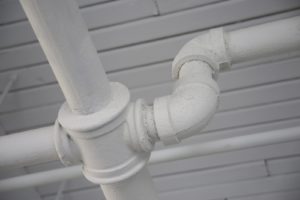 What is a P-trap? P-traps are part of your sink plumbing. Found under kitchen and bathroom sinks, these question-mark-shaped pieces of plumbing serve an important purpose…
What is a P-trap? P-traps are part of your sink plumbing. Found under kitchen and bathroom sinks, these question-mark-shaped pieces of plumbing serve an important purpose…
What Does a Plumbing P-Trap Do?
Whether they’re made of PVC or stainless steel, the P-traps beneath the drains in your home….
- Trap debris & prevent clogs
When cleaning your bathroom, you may notice a slow drain, indicating the P-trap has collected enough to become clogged. To prevent food waste, hair, and other things from clogging up your plumbing system, the bottom of the P-trap contains a small cleanout used to clear clogs the P-trap has contained. These clogs can usually be cleared with a plunger. However if this does not work, you may need to call a plumber. - Protect against property losses
Though not originally devised for this particular purpose, P-traps can also bail you out in a jewelry jam. If wedding rings, necklaces or other small, prized possessions accidentally slip into the sink drain, the P-trap may catch these valuables. - Stop sewer gases from infiltrating your home
Toxic and explosive, P-traps are designed to prevent sewer gases from seeping from pipes into your home. Prolonged exposure to these gases, which can include methane, hydrogen sulfide, nitrogen oxides, sulfur dioxide, ammonia and more, are more than a smelly annoyance. Prolonged exposure can cause health problems including cause headaches, fatigue, irritability, loss of appetite, memory issues, light-headedness, sinus infections, bronchitis, and even pneumonia. Exposure at high levels, such as those found in municipal sewers and industrial settings, can be fatal, however levels this high are typically not found in homes. If you notice a ‘rotten egg’ smell in your home – no need to evacuate. But you should call a plumber.
Is Your P-Trap Working Correctly? P Trap ‘Traps’
P-traps may seem like simple devices, but as with all things involving human error, things can go wrong. Common issues with P-traps Mr. Rooter Plumbing commonly rectifies include:
- P-trap overload
A single P-trap cannot handle the wastewater of more than 2-3 water-using appliances. - No tap primer on infrequently used fixtures
On traps that are rarely used, or in very dry climates, water in P-traps can evaporate, leading to the release of sewer gases into the home. In this scenario, a tap primer (or tap seal primer) should be added. These devices inject water into the P-trap as needed to ensure a water seal. - Insufficient ventilation
Drains without proper ventilation, such as those in older homes or cabins, will be slow to empty. Improper ventilation can be identified by listening for a ‘glug-glug’ sound from another drain in the house (other than the one emptying). The lack of ventilation in the emptying drain looks for release through neighboring lines, pushing/sucking air through an adjacent P-trap, emptying water from the trap, and potentially releasing sewer gases.

Recent Comments